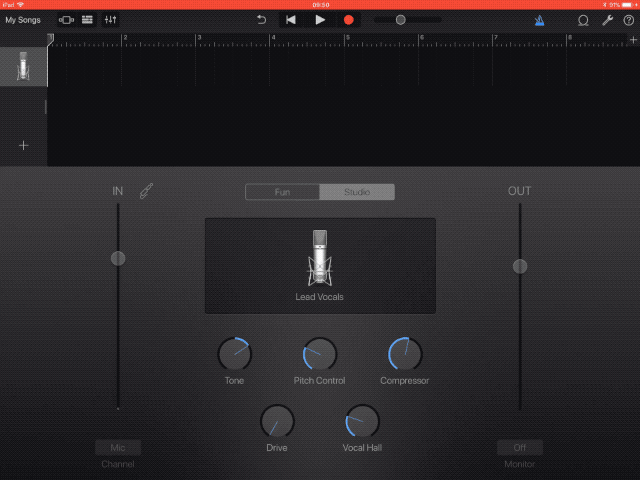Load Midi File Into Garageband Ipad
- Load Midi File Into Garageband Ipad To Pc
- How To Import Midi File To Garageband Ipad
- Load Midi File Into Garageband Ipad To Mac
- Load Midi File Into Garageband Ipad Free
Categories
Sep 18, 2018 How to import MIDI files in GarageBand iOS (iPad, iPhone) Close. How to import MIDI files in GarageBand iOS (iPad, iPhone). Updated to 12, and I still cannot put a midi file into GarageBand, any. Nov 01, 2017 You can open standard MIDI files in GarageBand. You can then view the notes in each track, change them, and change the instrument.
- How To Articles
GarageBand is a music production tool for OS X that allows users to create their own music and podcasts. Acting as both a music sequencer and digital audio workstation, GarageBand offers multi-track record and playback functionality, as well as audio filtering for sound enhancement and effects.
MIDI (Musical Instrument Digital Interface) tracks are files containing musical compositional data, that instruct compatible applications to play a sequence of music. Because they are just raw data, containing no actual sound, MIDI files are usually very small and transportable. MIDI files are commonly used as backing tracks by live bands, with the keyboard acting as the MIDI sequencer.
GarageBand is capable of importing and playing back MIDI files, which can then be added as a separate track (or tracks, depending on the file) to any project. MIDI files contain the note, instrument and timing data of a musical composition, and these can be modified in GarageBand after the file has been imported. Read on to learn more.
Related Download: GarageBand
Step-by-Step Instructions
- 1
Access the Related Download link for this article and click the Download Now link for GarageBand. Once the .dmg file has finished downloading, mount the file and drag the icon across to your Applications folder to install GarageBand (as per the usual OS X installation process).
Place a MIDI file on the desktop of your computer. If you do not have a MIDI file, there are thousands of free resources on the web - just Google 'free MIDI files', download a MIDI file to experiment with, and place it on your desktop.
- 3
Launch GarageBand using the shortcut in the Applications folder. If the Garageband interface fills the screen, reduce it slightly so the part of the desktop where your MIDI file is located is visible.
Drag the MIDI file into the GarageBand interface to import it into the application. The process takes a few seconds, depending on the length and complexity of the music, and gradually tracks are added to the current project timeline in GarageBand (a separate track for each instrument).
- 5
Some MIDI tracks contain system data alongside the musical instrument data. Locate any tracks in the timeline that were added as part of the MIDI import that do not appear to be actual musical data. These will often be very short, whereas the musical data will fill the entire timeline. In most cases, the 'tracks' that are very short in length will just be system messages, and these can be deleted by highlighting them and pressing Delete (this makes the project tidier and easier to work with).
Click the Play icon on the bottom tool bar to listen to the MIDI track you have imported. The data will be interpreted by GarageBand and played back with the closest instrument matches available. As the music plays, the marker progresses along the timeline, signifying the current point in the track. Press Stop to stop the track playback and halt the marker.
- 7
To change the tempo (speed) of the track, click the Tempo icon on the bottom toolbar and drag the slider up to increase the tempo, or down to decrease it. Press Play to listen to how the music sounds at the new speed.
To change the instrument of one of the tracks, click one of the tracks and then select the Info icon (i) at the bottom right hand side of the interface. A list of instruments is displayed, including the current selected instrument for that track. Select a new instrument by clicking it. Repeat this process for any tracks you wish to modify, then click the Play button to listen to how the track(s) sound with the modified instruments. /youtube-izotope-vocalsynth.html.
Tips & Advice
- If you want to save your modified music file, you cannot export it as a MIDI file using GarageBand, but you can save it as an MP3 or WAV file. Click File and choose Export, then select the filetype you wish to use and a filename.
Related Links
Add a Comment
TOP SPECIALS
| Free Microsoft Software: 75 Programs! |
| HD Wallpapers to Enhance Your Desktop |
| Top 50 Free Games of All Time |
| Top 50 Tools For Your USB Stick |
| 50 of the Hottest Wallpapers..EVER! |
Load Midi File Into Garageband Ipad To Pc
See All Download Special Articles
How To Import Midi File To Garageband Ipad
TOP 'HOW-TO' ARTICLES
| How to Create a Rule in Microsoft Outlook |
| How to Push Exchange Email to an iPhone |
| How to Use Virtual CD-ROM Control Panel |
| How to Add Skins to RocketDock |
| How to Turn Off TuneUp Utilities |

See More How To Articles